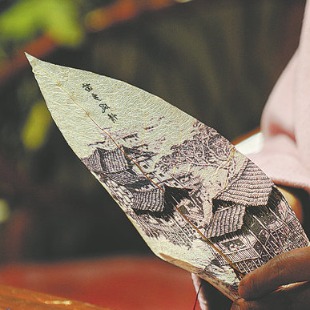



A small accident led to profound changes in the life of Yang Li, who is from the Miao ethnic group.
In 2011, Yang, from Tongren city in Guizhou province, created leaf-vein embroidery three months after a leaf cut her hand.
Through continuous learning and practice, she incorporated traditional embroidery of the Miao, Tujia and Dong ethnic groups into the leaves, creating unique art that blends the artificial with the natural.
A single piece of the leaf-vein embroidery sells for from 1,000 yuan ($143) to 10,000 yuan. Behind the basic financial facts is the more important story of the shared prosperity of embroiderers across the city and the export of culture far beyond the country's borders.
The embroidery is made from the leaves of rare plants from the Fanjing Mountain scenic area in Tongren city.
The veins are extracted by a process involving more than 30 steps, and then meticulously embroidered by skilled artisans.
The work is a perfect combination of traditional embroidery patterns and the natural textures of the leaves. It has a unique aesthetic appeal of traditional embroidery matched with the characteristics of contemporary craftsmanship.
In 2000, Yang enrolled in a human resources management program at Chongqing University and stayed in the city to work after graduation. In 2004, she got married and two years later her son was born. In 2008, her son fell seriously ill, and Yang quit her job in Chongqing and returned to Tongren to take care of the child.
As a native Miao woman with an innate love of embroidery, Yang opened a folk culture products shop with her sister in 2011, when her son's condition improved. The shop specialized in Miao embroidery, batik coarse cloth and silver jewelry. "People are becoming less familiar with traditional handicrafts, and I want to contribute all I can to change this situation," Yang says.
At first, the small shop did not earn a significant income as there were many similar products on the market. She gradually realized that it was important to establish her own brand and launch products with distinct features.
That's when she was inspired by the cut. In July 2011, Yang accidentally cut her hand on a thorny leaf when she was hiking in Fanjing Mountain.
A bold idea came into her head: "There are leaf-vein bookmarks and leaf-vein paintings. Why has nobody created leaf-vein embroidery yet?"
Obviously, the reason behind this is that embroidering on leaves requires delicate skills that few possess.

Yang collected thousands of leaves from the forest in Fanjing Mountain, and after steaming, boiling and tanning, the flesh was removed, exposing the veins. When they dried, the leaves became brittle.
During that time her room was like a swamp, with leaves of all shapes and sizes covering the floor, with the smell of decaying plants filling the air.
The biggest technical challenge Yang faced was improving the flexibility of the leaves and making them as soft as cloth.
In September 2011, she visited Shen Min, a local folklore expert and botanist, several times until he told her to soak the leaves in acidic water to weaken the alkalinity of the leaves, thus making the fibers of the veins tough enough to embroider on.
On Oct 16, a day she will never forget, Yang finally created a shiny, thin and unbreakable piece of leaf vein. Her idea of leaf-vein embroidery came to fruition after hundreds of experiments.
In November of the same year, her work won her the special award of "Guizhou artisan", fame and a great number of orders.
Two years later, Yang opened an embroidery processing factory and offered jobs to more than 500 laid-off female workers, rural women and people with disabilities.
The leaves turn soft after the process, but are also extremely fragile. Yang claims that from 2011 to now, there are only fewer than 20 people who can independently complete the whole leaf-embroidery process in Tongren.
"Usually the embroiderers who can handle the job are those who have already practiced embroidery for decades," she says.
Yang claims that almost every embroiderer has a collection of handicrafts in her home that could fill a museum.
"Guizhou is a province with a large number of ethnic groups and has a long history of ethnic embroidery skills," she says.
"I will keep doing the leaf-vein embroidery for the rest of my life because it is meaningful."
In the next five years, Yang has a few plans related to the number 100.
"I will work with 100 artisans or companies to expand my product range to 100, and help 100 mothers to become excellent artisans," she says.
Wang Jin contributed to the story.




If you have any problems with this article, please contact us at app@chinadaily.com.cn and we'll immediately get back to you.